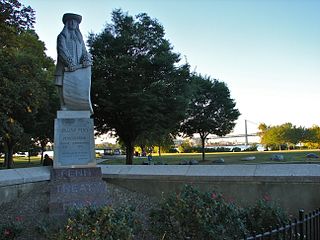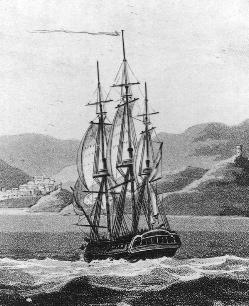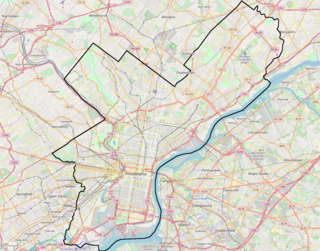
Philadelphia, sometimes known colloquially as Philly, is the largest city in the U.S. state and Commonwealth of Pennsylvania, and the sixth-most populous U.S. city, with a 2017 census-estimated population of 1,580,863. Since 1854, the city has been coterminous with Philadelphia County, the most populous county in Pennsylvania and the urban core of the eighth-largest U.S. metropolitan statistical area, with over 6 million residents as of 2017. Philadelphia is also the economic and cultural anchor of the greater Delaware Valley, located along the lower Delaware and Schuylkill Rivers, within the Northeast megalopolis. The Delaware Valley's population of 7.2 million ranks it as the eighth-largest combined statistical area in the United States.

Michael Francis Egan was an Irish, later American, prelate of the Roman Catholic Church. He was born in Ireland in 1761, and joined the Franciscan Order at a young age. He served as a priest in Rome, Ireland, and Pennsylvania and became known as a gifted preacher. In 1808, Egan was appointed the first Bishop of Philadelphia, and held that position until his death in 1814. Egan's tenure as bishop saw the construction of new churches and the expansion of the Catholic Church membership in his diocese, but much of his time was consumed by disputes with the lay trustees of his pro-cathedral, St. Mary's Church in Philadelphia. He died in Philadelphia, probably of tuberculosis, in 1814.

Northeast Philadelphia, nicknamed Northeast Philly, the Northeast and the Great Northeast, is a section of the City of Philadelphia, Pennsylvania. According to the 2000 Census, the Northeast has a sizable percentage of the city's 1.547 million people—a population of between 300,000 and 450,000, depending on how the area is defined. Beginning in the 1980s, many of the Northeast's middle class children graduated from college and settled in suburbs, especially nearby Bucks County. The Northeast is home to a large working class Irish American population, but is also home to Polish, German, Jewish, Italian, Portuguese and Russian neighborhoods.

South Philadelphia, nicknamed South Philly, is the section of Philadelphia bounded by South Street to the north, the Delaware River to the east and south, and the Schuylkill River to the west. A diverse community, South Philadelphia is especially known for its large Italian American population, but also contains large Irish American and African American populations.

Kensington is a neighborhood in Philadelphia, Pennsylvania. It is between the Lower Northeast section of Philadelphia and North Philadelphia and is not part of either of these neighborhoods but is considered one of the Riverward neighborhoods. Modern Kensington is larger than the former Kensington District, and unlike Kensington District it does not include Fishtown. As with all neighborhoods in Philadelphia, the lack of any official designation means the boundaries of the area vary between sources and over time.
Philadelphia, Here I Come! is a 1964 play by Irish dramatist Brian Friel. Set in the fictional town of Ballybeg, County Donegal, the play launched Friel onto the international stage.

Gazela is a wooden tall ship, built in 1901, whose home port is Philadelphia. She was built as a commercial fishing vessel, and used in that capacity for more than sixty years. She now serves as the maritime goodwill ambassador for the City of Philadelphia, the Commonwealth of Pennsylvania, and the Ports of Philadelphia and Camden, New Jersey. She has been featured in a number of films, and participated in domestic and international events, including OpSail 2000.

Mayfair, centered on the intersection of Cottman and Frankford Avenues. It is bordered by Tacony and Wissinoming to the south and east, Holmesburg to the east, Pennypack Park to the north, and Oxford Circle and Rhawnhurst to the west. Mayfair is home to a large Irish American population.

West Kensington is a neighborhood in the North Philadelphia section of Philadelphia. It is north of Olde Kensington. The Market Frankford El above Front Street forms the line between West Kensington and Kensington. Its bordering neighborhoods are Kensington to the east, Harrowgate to the northeast, and Fairhill to the west. It is bounded by Kensington Avenue to the east, American Street to the west, York Street to the South and Allegheny Avenue to the north.

Grays Ferry, also known as Gray's Ferry, is a neighborhood in South Philadelphia bounded (roughly) by 25th Street on the east, the Schuylkill River on the west, Vare Avenue on the south, and Grays Ferry Avenue on the north. The section of this neighborhood west of 34th Street is also known as Forgotten Bottom. Grays Ferry shares borders with Southwest Center City to the North, Point Breeze to the East, and Girard Estate to the South. Gray’s Ferry is across from where Mill Creek debouches at about 43rd street. Historically, Grays Ferry was one of the largest enclaves of Irish Americans in the city, and while there are still many Irish left, it is now home to a significant African American population.
As of the 2010 United States Census, there were 1,526,006 people, 590,071 households, and 352,272 families residing in the consolidated city-county of Philadelphia, Pennsylvania. The population density was 4,337.3/km² (11,233.6/mi²). There were 661,958 housing units at an average density of 1,891.9/km² (4,900.1/mi²).

"Streets of Philadelphia" is a song written and performed by American rock musician Bruce Springsteen for the film Philadelphia (1993), an early mainstream film dealing with HIV/AIDS. Released as a single in 1994, the song was a hit in many countries, particularly Canada, France, Germany, Ireland and Norway, where it topped the singles charts.

Pennsport is a neighborhood in the South Philadelphia section of Philadelphia, Pennsylvania, United States.

The Philadelphian cricket team was a team that represented Philadelphia, Pennsylvania, in first-class cricket between 1878 and 1913. Even with the United States having played the first ever international cricket match against Canada in 1844, the sport began a slow decline in the U.S. This decline was furthered by the rise in popularity of baseball. In Philadelphia, however, the sport remained very popular and from the end of the 19th century until the outbreak of World War I, the city produced a first class team that rivaled many others in the world. The team was composed of players from the four chief cricket clubs in Philadelphia–Germantown, Merion, Belmont, and Philadelphia. Players from smaller clubs, such as Tioga and Moorestown, and local colleges, such as Haverford and Penn, also played for the Philadelphians. Over its 35 years, the team played in 88 first-class cricket matches. Of those, 29 were won, 45 were lost, 13 were drawn and one game was abandoned before completion.
Events from the year 1776 in Ireland.

The Philadelphia Badlands is a section of North Philadelphia, Pennsylvania, United States, that is known for an abundance of open-air recreational drug markets and drug-related violence. It has amorphous and somewhat disputed boundaries, but is generally agreed to include the 25th police district.
Polish-American organized crime has existed in the United States throughout the 20th and 21st centuries. Although not as well known as Italian, Irish, Russian or Jewish mafias, the Polish mob has a presence in many urban Polish American communities.

Swampoodle is an older neighborhood in North Philadelphia. Swampoodle was defined as the vicinity of the junction of three railroad lines near Lehigh Avenue and 22nd Streets.
William Francis Harrity was an American politician and lawyer. Harrity is best known as chairperson of the Democratic National Committee from 1892 to 1896. He also served as Secretary of the Commonwealth of Pennsylvania between 1891 through 1895.
Irish Americans are an ethnic group comprising Americans who have full or partial ancestry from Ireland, especially those who identify with that ancestry, along with their cultural characteristics. About 33 million Americans — 10.5% of the total population — reported Irish ancestry in the 2013 American Community Survey conducted by the U.S. Census Bureau. This compares with a population of 6.7 million on the island of Ireland. Three million people separately identified as Scotch-Irish, whose ancestors were Ulster Scots and Anglo-Irish Protestant Dissenters who emigrated from Ireland to the United States. However, whether the Scotch-Irish should be considered Irish is disputed.















